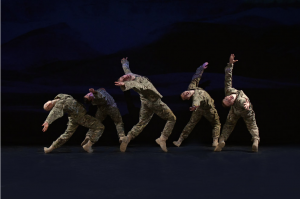In “5 Soldiers,” 5 Dancers Offer Gripping Take on Military Life
 Dance and the military may inhabit separate worlds, but when British choreographer Rosie Kay was recovering from an injury, she was struck by the way that both dancers and soldiers put their bodies on the line. That led her to doing movement research by training with the British Army and creating the gripping, powerful “5 Soldiers: The Body is the Frontline.”
Dance and the military may inhabit separate worlds, but when British choreographer Rosie Kay was recovering from an injury, she was struck by the way that both dancers and soldiers put their bodies on the line. That led her to doing movement research by training with the British Army and creating the gripping, powerful “5 Soldiers: The Body is the Frontline.”
The piece debuted 10 years ago and has received some of Britain’s top dance honors. And it’s running here for two more nights. Go!
Presented by UCSD Artpower, “5 Soldiers” takes place at the White Box Theater at Liberty Station. The intimate space is ideal for Kay’s intimate, intense take on soldiers training, living, and ultimately risking their lives together. It’s ideal, as well, given Liberty Station’s history as a Naval training facility and whatever psychic resonance from those eager, scared, brave young sailors lingers in the walls.
Kay structures the piece in four parts: drill, leisure time, combat, and rehab. In “Drill,” the five dancers—wearing camouflage uniforms—trot-march in disciplined formation, doing tight 90- and 180-degree pivots to change direction. They take turns lying prone and diving over each other. They even breathe in unison, as projections of white-on-black computer code fill the back wall.
“You’re dead,” the mustached commander (Frankie Hickman) says to a soldier in a war game. The “victim” hits the ground and gets carried off by the others.
In the leisure section, the guys roughhouse and female soldier Harriet Ellis strips down to her skivvies, wields a powder puff, and does luxurious, sensual stretches, reclaiming her femininity. It’s a mixed blessing. The three men stalk her and lift her like a prize. (The piece is supposed to have four men and just one woman, and presumably all four would have menaced Ellis. But one dancer had visa problems, and Kay is taking his place here—performing in her own dance for the first time. During much of this section, she “napped” at the back of the stage.)
Later, Ellis and Jonathan Mewett do a sweet pas de deux using one of the eight rubber tires scattered over the stage. The score, which has alternated between pop tunes and an ominous drone, suddenly switches to Pergolesi’s glorious Stabat Mater Dolorosa.
Packs on their backs, all five sit around a square of light as the score gives us a helicopter roar, and video shows a landscape of fields. In a wonderful bit, they link arms like skydivers and lean into an arabesque. Then they’re on the ground, semi-crouching as they move through hostile territory. There’s a pop of gunshots, and they break into two lines, one scrambling a few feet forward, then gesturing to the other to advance.
Olly Bell—the wiseass who always balks at following orders—gets hit. He pulls himself on his belly, as the others crowd around, and Ellis says, “You’re going to be okay.” (The dancers speak only a few times, but we get their characters from their actions.)
In the last section, Bell attempts to walk on his knees and falls again and again. Finally, alone center-stage, he repeats a drill from the beginning, marching with thrusting straight arms but on half-legs.

Award-winning dance journalist Janice Steinberg has published more than 400 articles in the San Diego Union-Tribune, Dance Magazine, the Los Angeles Times, and elsewhere. She was a 2004 New York Times-National Endowment for the Arts fellow at the Institute for Dance Criticism and has taught dance criticism at San Diego State University. She is also a novelist, author of The Tin Horse (Random House, 2013). For why she’s passionate about dance, see this article on her web site, The Tin Horse
